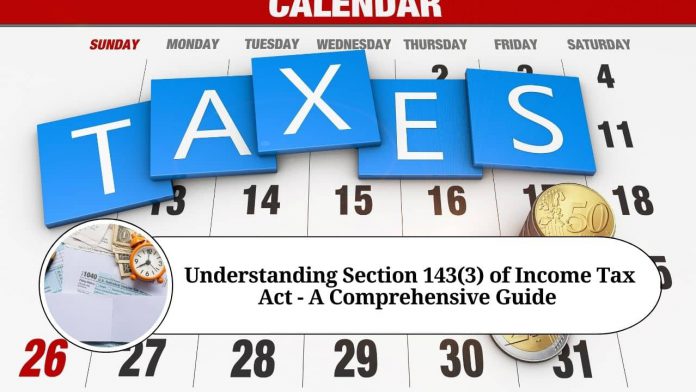The Indian Income Tax Act, of 1961 is the primary legislation that governs taxation in India. It is a complex set of laws, rules, and regulations that are often challenging to understand for ordinary taxpayers. One such section is Section 143(3), which deals with the processing of income tax returns by the income tax department. This article aims to provide a comprehensive guide to Section 143(3) of the Income Tax Act.
What is Section 143(3) of the Income Tax Act?
Section 143(3) of the Income Tax Act deals with the processing of income tax returns. It empowers the income tax department to scrutinize an income tax return filed by a taxpayer and issue a notice to the taxpayer if any discrepancies or errors are found in the return.
Procedure for Processing Income Tax Returns under Section 143(3):
The following steps are involved in the processing of income tax returns under Section 143(3):
Step 1: Acknowledgment of Income Tax Return Once a taxpayer files their income tax return, the income tax department issues an acknowledgment to the taxpayer. This acknowledgment contains the details of the income tax return filed, including the taxable income, tax liability, and the tax paid.
Step 2: Processing of Income Tax Return After receiving the income tax return, the income tax department processes the return. This process involves verifying the details mentioned in the return against the records available with the department. The department also checks if any tax refunds are due to the taxpayer.
Step 3: Issue of Intimation Notice After processing the income tax return, the income tax department issues an intimation notice to the taxpayer under Section 143(1). This notice contains the details of the income tax return filed, the tax payable or refundable, and any adjustments made by the department.
Step 4: Scrutiny Assessment under Section 143(3) If the income tax department finds any discrepancies or errors in the income tax return filed by the taxpayer, they can initiate a scrutiny assessment under Section 143(3). This assessment is a detailed investigation into the income tax return filed by the taxpayer.
Step 5: Issue of Notice for Scrutiny Assessment If the income tax department decides to initiate a scrutiny assessment, they will issue a notice to the taxpayer under Section 143(2) of the Income Tax Act. This notice will require the taxpayer to furnish additional information or documents to support their income tax return.
Step 6: Conducting Scrutiny Assessment After receiving the additional information and documents from the taxpayer, the income tax department conducts a scrutiny assessment. This assessment involves verifying the income and tax details mentioned in the income tax return filed by the taxpayer.
Step 7: Issue of Assessment Order After completing the scrutiny assessment, the income tax department issues an assessment order under Section 143(3) of the Income Tax Act. This order contains the details of the assessment, including the taxable income, tax liability, and any adjustments made by the department.
Conclusion:
Section 143(3) of the Income Tax Act is an important provision that enables the income tax department to scrutinize the income tax returns filed by taxpayers. The provision aims to ensure that taxpayers comply with the provisions of the Income Tax Act and pay their taxes correctly.
Read Other Useful Blogs:
Taxpayers need to understand the procedure for processing income tax returns under Section 143(3) to avoid any penalties or legal consequences for non-compliance with the Income Tax Act. Taxpayers should also ensure that they file their income tax returns correctly and provide accurate information to the income tax department to avoid any scrutiny assessments.
Frequently Asked Questions:
Q1. What is Section 143(3) of the Income Tax Act?
A1. Section 143(3) of the Income Tax Act is a provision that empowers the income tax department to scrutinize the income tax returns filed by taxpayers and issue a notice to them if any discrepancies or errors are found in the return.
Q2. When is a scrutiny assessment initiated under Section 143(3)?
A2. A scrutiny assessment under Section 143(3) is initiated if the income tax department finds any discrepancies or errors in the income tax return filed by the taxpayer.
Q3. What is the procedure for processing income tax returns under Section 143(3)?
A3. The procedure for processing income tax returns under Section 143(3) involves the acknowledgment of the income tax return filed by the taxpayer, processing of the return, issuing an intimation notice, initiating a scrutiny assessment if necessary, issuing a notice for scrutiny assessment, conducting scrutiny assessment, and issuing an assessment order.
Q4. What is the purpose of Section 143(3) of the Income Tax Act?
A4. The purpose of Section 143(3) of the Income Tax Act is to ensure that taxpayers comply with the provisions of the Income Tax Act and pay their taxes correctly.
Q5. What happens if a taxpayer fails to comply with the notice issued under Section 143(3)?
A5. If a taxpayer fails to comply with the notice issued under Section 143(3), they may face penalties or legal consequences for non-compliance with the Income Tax Act.
Q6. Can a taxpayer request a review of the assessment order issued under Section 143(3)?
A6. Yes, a taxpayer can request a review of the assessment order issued under Section 143(3) by filing an appeal with the Commissioner of Income Tax (Appeals).
Q7. What should taxpayers do to avoid scrutiny assessments under Section 143(3)?
A7. Taxpayers should ensure that they file their income tax returns correctly and provide accurate information to the income tax department to avoid any scrutiny assessments. They should also comply with the notices issued by the department under Section 143(3).




















